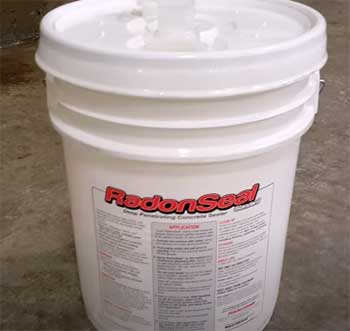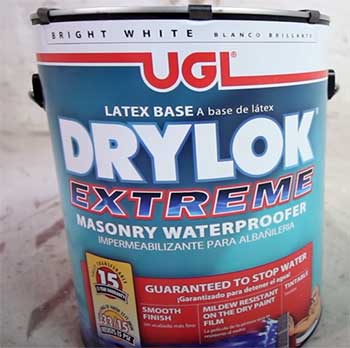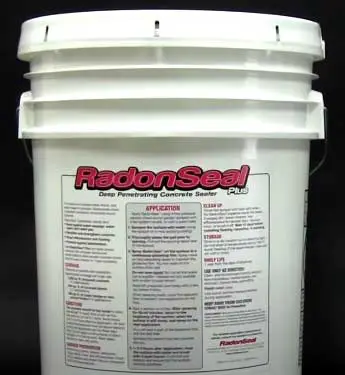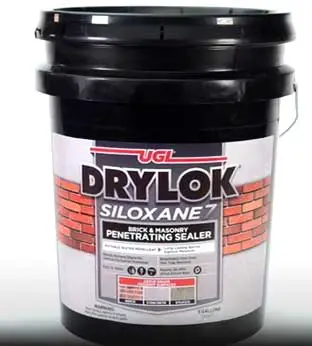Concrete sealer is one of the important elements for the walls and floors because it keeps the concrete dry and rigid.
It prevents water absorption and protects the concrete from excess moisture which increases the lifetime of the concrete.
RadonSeal and Drylok are two popular options for concrete sealing. These are also used for preventing water and gas seepage.
If you’re confused between these two options, go through this RadonSeal vs. Drylokanalysis which will help you choose the right one.
A Quick Comparison Between The Two Waterproofers
When it comes to the matter of walls and floor protection, Radonseal and Drylok are the best. But still, these two have some differences and specifications.
Here’s a quick comparison table between these two options for your better understanding-
| Specifications | RadonSeal | Drylok |
| Variant | RadonSeal Standard, Radonseal Plus | Drylok concrete floor paint, Drylok wetlook, Drylok Extreme, Drylok Firstplug etc. |
| Type | Water-based concrete sealer | Latex or oil-based paint |
| Uses | Floors, walls | Mainly on the walls |
| Cost | Expensive | Cheaper than Radonseal |
| Application | A little bit complex | Easy |
| Coverage | Cinder Blocks: 80 sq. ft. per gallon. Limestone 175-225 sq. ft. per gallon. Stucco: 200-250 sq. ft. per gallon. Poured Concrete: 200 sq. ft. per gallon. Concrete Blocks: 100 sq. ft. per gallon. | 75 – 100 square feet per gallon with Drylok extreme, 90 – 100 square feet per gallon with Drylok floor Masonry waterproofer. |
| Longevity | Over ten years | Drylok Extreme Masonry Waterproofer- fifteen years, Drylok Floor and Wall Masonry Waterproofer- almost seven years, Drylok Original Masonry Waterproofer- ten years. |
In-depth Differences Between Radonseal and Drylok
In this section, you will get to know about a detailed comparison between RadonSeal and Drylok:
- Variant

Drylok has more product variants than RadonSeal.
It has almost six types of waterproofers, and concrete sealers, whereas RadonSeal has only two- RadonSeal standard and RadonSeal Plus.
RadonSeal standard is used in mainly houses and basements.
On the other hand, RadonSeal plus give extra rigidity, and that’s why it is used in commercial areas.
Drylok has different types of waterproofers and sealers for different purposes. For example, you can find a separate Drylok concrete sealer for the floor.
Drylok extreme, Drylok Wetlook, Drylok original masonry waterproofer are some other options. Drylok Wetlook has become very popular nowadays because it gives a glossy look to the floor or wall, enhancing the beauty and protecting the concrete.
- Type
There are different types of waterproofing materials or concrete sealers available in the market. Penetrating, Acrylic, Polyurethanes, Epoxies, etc., are some popular ones.
RadonSeal is a water-based concrete sealer that is almost the same as the penetrating sealers. The water-based sealer’s main benefit is that it can penetrate easily into the concrete pores and block them.
It also creates a layer outside that prevents water and gas from seeping.
Drylok is a kind of acrylic, latex, or oil-based product. This type of sealer is great for those who want a smooth finish and perfect layer on their walls and floors.
But one of the major disadvantages of this type of sealer is that it does not go inside the concrete pores. So, radon or other types of gas can be created even though the Drylok is applied, which can eventually cause harm to the concrete wall.
- Uses
If you want a one-stop solution for your house, office, or basement, RadonSeal will be the best solution for you.
Because with RadonSeal standard or plus, you can cover both floors and walls.
But if you want to use Drylok, it won’t cover your floor. You have to buy a separate kind of Drylok which is only made for the floors.
As the Drylok waterproofer is latex or oil-based, it is not really suitable for the floors.
Another thing you have to keep in mind is that you can apply Drylok over the paint on the wall. But in the case of RadonSeal concrete sealer, it is best to remove the paint first.
As the RadonSeal is generally applied with the spraying machine, it cannot give a smooth finish if there’s anything excess on the floors or walls.
- Cost

If you have a budget issue, you can choose Drylok.
Drylok will meet your demand with a limited budget.
Drylok extreme waterproofer will cost you almost $35 per gallon, and Drylok floor and wall waterproof will cost $165 for 5 gallons or nearly $33 per gallon.
Compared with Drylok, RadonSeal is pretty expensive.
2.5-gallon RadonSeal Deep-Penetrating Concrete Sealer will cost you $119, and a 5-gallon costs $281, which is almost $116 higher than Drylok.
- Application
The application of RadonSeal is a little bit more complicated than Drylok. This is because you can not apply RadonSeal concrete sealer in the traditional way. You have to use a pump-up sprayer for applying this sealer.
With a pump-up sprayer, spray on an even coat sealer on the wall or floor. You have to make sure that you’re completely soaking the concrete with the sealer.
As the RadonSeal is applied with a sprayer, you need to be conscious about your safety so that any product cannot get into your touch.
On the other hand, most Drylok is applied with the traditional method. First, take a drywall knife and scrape off the old paint and dirt. You can also use an angle grinder to make sure a smooth finish.
After all the prep work, here comes the main part. You can also use Drylok Fast Plug if there’s any major crack in the wall.
Then take a Drylok brush, and apply the Drylok Extreme or any other variant of Drylok waterproofer as your preference. Move your brush horizontally for a better finish.
Also, check twice to find out if there are any spots left behind when applying.
- Coverage
As Radonseal is a water-based sealer and applied with a sprayer, it covers more area than Drylok with a single gallon. However, RadonSeal works differently on different surfaces.
Cinder Blocks: 80 sq. ft., limestone: 175-225 sq. ft., stucco: 200-250 sq. ft., poured concrete: 200 sq. ft., and concrete blocks: 100 sq. ft. can be covered with per gallon RadonSeal. But if you want a double layer for better protection, you’ll need more sealer.
Drylok is also used on these surfaces, and 90-100 sq. ft. can be easily covered with a gallon of Drylok.
Key Features of RadonSeal Water-Repellent Sealer
RadonSeal from Ghostshield is a premium-grade water-repellent sealer designed to protect exterior masonry and concrete surfaces. It contains a 40% silane formula that provides long-lasting waterproofing performance.
- Advanced Silane Formula

The key to RadonSeal’s effectiveness is the 40% silane active ingredient.
Silane chemically reacts with inorganic substrates to form a durable water-repellent barrier.
Unlike surface coatings, RadonSeal penetrates deep into concrete and masonry to provide effective waterproofing protection.
The silane active forms a hydrophobic barrier within the capillaries and pores below the surface.
This water-repellent reaction is permanent and won’t peel, flake or wear away over time. RadonSeal provides 10+ years of reliable waterproofing protection for concrete and masonry.
- Repels Liquid Water
RadonSeal creates an effective liquid repellent barrier on mineral building materials. When applied properly, the silane-treated surface will repel rainwater and prevent moisture intrusion.
Testing shows that RadonSeal achieves a water absorption reduction of 90% or more on concrete and masonry. This huge reduction in absorbed water helps prevent freeze-thaw damage, mildew and efflorescence.
- Protection Against Efflorescence
Efflorescence is the white salt deposit that can form on concrete and masonry surfaces. It is caused by water carrying dissolved salts from inside the material to the surface which then precipitates out.
By preventing water intrusion, RadonSeal greatly minimizes efflorescence problems on treated surfaces. Keeping the water out stops the main mechanism that forms unsightly efflorescence.
- Lets Vapor Escape
While RadonSeal effectively repels liquid water, it still allows interior moisture vapor to pass through. This “breathability” is vital to avoid trapping moisture inside the material.
The hydrophobic water-repellent lining allows water vapor molecules to diffuse and escape. This prevents spalling, cracking and other issues caused by trapped moisture.
- UV Resistant
RadonSeal contains UV stabilizers that prevent breakdown from ultraviolet radiation exposure. The water-repellent properties will remain stable without yellowing or wearing away.
- Low VOC Content
RadonSeal has a low VOC (Volatile Organic Compound) content of less than 250 g/L. This makes it compliant for use in all areas.
The water-based formula also has very low odor during application.
- Ease of Application
RadonSeal goes on easily with low-pressure hand pump spray equipment. It soaks into the subsurface leaving no surface residue or shine.
Cleanup requires only soap and water. RadonSeal won’t harm glass, metal or plastic surfaces if accidentally oversprayed.
With proper surface preparation and application, RadonSeal provides long-lasting waterproofing protection for concrete, brick, stucco, grout and other masonry materials. It’s an ideal solution for preventing moisture damage and efflorescence problems.
Key Features of Drylok Water-Repellent Sealer
Drylok Waterproofing Sealer is a water-based silane/siloxane sealer designed to protect exterior masonry surfaces. It provides long-lasting water repellency to prevent moisture damage on brick, concrete, stucco and more.
- Advanced Silane-Siloxane Formula

The key water-repelling component in Drylok Sealer is a proprietary blend of silane and siloxane.
These silicon-based chemicals provide a high-quality water barrier.
Silanes work by chemically reacting with masonry to form covalent bonds within the pores.
This permanently modifies the substrate to become hydrophobic and repel water.
Siloxanes coat the surface with a durable water-repellent lining. The combination of silane and siloxane gives Drylok its superior wetting protection.
- Repels Liquid Water
Drylok Sealer creates an effective liquid water barrier to prevent rain and moisture from being absorbed. Properly treated surfaces will force water to bead up and run off the surface.
Testing shows Drylok reduces water absorption by over 80% compared to untreated masonry. This water repellency helps stop freeze-thaw damage, efflorescence, and interior water penetration.
- Breathable Vapor Barrier
While Drylok effectively repels liquid water, it still allows interior moisture vapor to pass through. This breathability ensures no moisture gets trapped inside the masonry.
Drylok’s microporous structure doesn’t clog the pores completely. This maintains the natural vapor diffusion properties of the masonry.
- UV Resistant
Drylok contains UV inhibitors that prevent breakdown from sun exposure. It won’t peel, crack or yellow when exposed to ultraviolet light.
- Low VOC Formula
Drylok Sealer has a low VOC (Volatile Organic Compound) content under 100 g/L. It meets stringent VOC regulations making it ideal for all regions.
The water-based formula is also low odor for easier application.
- Easy Spray Application
Drylok Sealer goes on easily with low-pressure hand pump spray equipment. It penetrates into the masonry leaving no residue or surface film.
Simple soap and water cleanup. Won’t harm windows, metal, or other surfaces if accidentally oversprayed.
With its advanced silane-siloxane formula and UV resistant protection, Drylok provides long-lasting water repellency for exterior masonry surfaces. Just 2 coats creates an effective barrier against rainwater and moisture damage.
Frequently Asked Questions (FAQs)
Thoroseal and RadonSeal can be better options than Drylok. However, Drylok is less expensive than these two and easy to apply. It also works better against vapor.
Yes, you can use Drylok on the basement walls. Drylok will protect your basement wall from water and gas seepage as well as keep your basement clean.
No, Drylok does not cause mold; rather, it prevents the wall from developing any sort of mold and fungus. Because its main goal is to prevent the water and dirt from penetrating the wall and keep the concrete fresh.
Yes. RadonSeal is also known as a waterproofer which prevents water seepage and radon gas from the concrete.
Final Words
RadonSeal vs. Drylokcan be a difficult comparison as both have their strengths and weaknesses. You might be wondering which one to choose. Well, it depends on the budget, surface, and some other things.
If you don’t have any budget issues, you should choose RadonSeal for better coverage. But you might need some professional help when applying.
You can also choose Drylok if it’s for your basement wall. Drylok will be the best choice if you’re thinking about DIY. We hope this article helps you make the right choice.

Thanks for great detailed information! Good comparisons